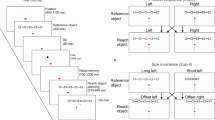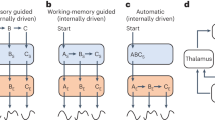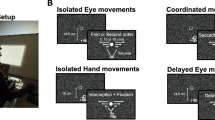Abstract
When we reach out to pick something up, our arm is directed to the target by visuomotor networks in the cortical dorsal stream. However, our reach trajectories are influenced also by nontarget objects, which might be construed as potential obstacles. We tested two patients with bilateral dorsal-stream (parietal lesions, both of whom were impaired at pointing to visual stimuli (optic ataxia). We asked them to reach between two cylinders, which varied in location from trial to trial. We found that the patients' reaches remained invariant with changes in obstacle location. In a control task when they were asked to point midway between the two objects, however, their responses shifted in an orderly fashion. We conclude that the dorsal stream provides the visual guidance we automatically build into our movements to avoid potential obstacles, as well as that required to ensure arrival at the target.
This is a preview of subscription content, access via your institution
Access options
Subscribe to this journal
Receive 12 print issues and online access
$209.00 per year
only $17.42 per issue
Buy this article
- Purchase on Springer Link
- Instant access to full article PDF
Prices may be subject to local taxes which are calculated during checkout





Similar content being viewed by others
References
Jeannerod, M. The Cognitive Neuroscience of Action (Blackwell, Oxford, 1997).
Caminiti, R., Ferraina, S. & Mayer, A.B. Visuomotor transformations: early cortical mechanisms of reaching. Curr. Opin. Neurobiol. 8, 753–761 (1998).
Culham, J.C. & Kanwisher, N.G. Neuroimaging of cognitive functions in human parietal cortex. Curr. Opin. Neurobiol. 11, 157–163 (2001).
Connolly, J.D., Andersen, R.A. & Goodale, M.A. FMRI evidence for a 'parietal reach region' in the human brain. Exp. Brain Res. 153, 140–145 (2003).
Tresilian, J.R. Attention in action or obstruction of movement? A kinematic analysis of avoidance behaviour in prehension. Exp. Brain Res. 120, 352–368 (1998).
Milner, A.D. et al. Perception and action in 'visual form agnosia'. Brain 114, 405–428 (1991).
James, T.W., Culham, J., Humphrey, G.K., Milner, A.D. & Goodale, M.A. Ventral occipital lesions impair object recognition but not object-directed grasping: a fMRI study. Brain 126, 2463–2475 (2003).
Himmelbach, M. & Karnath, H.-O. Goal-directed hand movements are not affected by the biased space representation in spatial neglect. J. Cogn. Neurosci. 15, 972–980 (2003).
Harvey, M. et al. Is grasping impaired in hemispatial neglect? Behav. Neurol. 13, 17–28 (2002).
McIntosh, R.D., Pritchard, C.L., Dijkerman, H.C., Milner, A.D. & Roberts, R.C. Prehension and perception of size in left visuospatial neglect. Behav. Neurol. 13, 3–15 (2002).
McIntosh, R.D., McClements, K.I., Dijkerman, H.C., Birchall, D. & Milner, A.D. Preserved obstacle avoidance during reaching in patients with left visual neglect. Neuropsychologia 42, 1107–1117 (2004).
Perenin, M.-T. in Parietal Lobe Contributions to Orientation in 3D Space (eds. Thier, P. & Karnath, H.-O.) 289–308 (Springer, Heidelberg, 1997).
Perenin, M.-T. & Vighetto, A. Optic ataxia: a specific disruption in visuomotor mechanisms. I. Different aspects of the deficit in reaching for objects. Brain 111, 643–674 (1988).
Milner, A.D. & McIntosh, R.D. Reaching between obstacles in spatial neglect and visual extinction. Prog. Brain Res. 144, 213–226 (2003).
Crawford, J.R. & Garthwaite, P.H. Investigation of the single case in neuropsychology: confidence limits on the abnormality of test scores and test score differences. Neuropsychologia 40, 1196–1208 (2002).
Pisella, L. et al. An 'automatic pilot' for the hand in human posterior parietal cortex: toward reinterpreting optic ataxia. Nat. Neurosci. 3, 729–736 (2000).
Gréa, H. et al. A lesion of the posterior parietal cortex disrupts on-line adjustments during aiming movements. Neuropsychologia 40, 2471–2480 (2002).
McIntosh, R.D. et al. Avoidance of obstacles in the absence of visual awareness. Proc. R. Soc. Lond. B 271, 15–20 (2004).
Milner, A.D. & Goodale, M.A. The Visual Brain in Action (Oxford Univ. Press, Oxford, 1995).
Goodale, M.A. & Milner, A.D. Sight Unseen: Explorations in Conscious and Unconscious Vision (Oxford University Press, Oxford, 2004).
Mon-Williams, M., Tresilian, J.R., Coppard, V.L. & Carson, R.G. The effect of obstacle position on reach-to-grasp movements. Exp. Brain Res. 137, 497–501 (2001).
Rossetti, Y. & Pisella, L. Taking Action: Cognitive Neuroscience Perspectives on Intentional Acts (ed. Johnson-Frey, S.H.) 67–105 (MIT Press, Cambridge Massachusetts, 2003).
Pisella, L. et al. in Studies in Perception and Action (eds. Grealy, M. & Thomson, J.A.) 275–279 (Erlbaum, Hillsdale, New Jersey, 1999).
Rossetti, Y. et al. Visually guided reaching: posterior parietal lesions cause a switch from fast visuomotor to slow cognitive control. Neuropsychologia (in the press).
Acknowledgements
The authors thank patients A.T. and I.G. for their patience and cooperation. They also thank the Medical Research Council (Co-operative Group grant no. G0000003), the Leverhulme Trust (Research Interchange grant no. F/00128/O), and Programme Hospitalier de Recherche Clinique (PHRC) from the French Ministry of Health, for their financial support of this research.
Author information
Authors and Affiliations
Corresponding author
Ethics declarations
Competing interests
The authors declare no competing financial interests.
Rights and permissions
About this article
Cite this article
Schindler, I., Rice, N., McIntosh, R. et al. Automatic avoidance of obstacles is a dorsal stream function: evidence from optic ataxia. Nat Neurosci 7, 779–784 (2004). https://doi.org/10.1038/nn1273
Received:
Accepted:
Published:
Issue Date:
DOI: https://doi.org/10.1038/nn1273
This article is cited by
-
Eye–hand coordination: memory-guided grasping during obstacle avoidance
Experimental Brain Research (2022)
-
Intensional biases in affordance perception: an explanatory issue for radical enactivism
Synthese (2021)
-
Lessons from human vision for robotic design
Autonomous Intelligent Systems (2021)
-
Motor Abilities and the Motor Profile in Individuals with Williams Syndrome
Advances in Neurodevelopmental Disorders (2021)
-
Neural Networks Mediating Perceptual Learning in Congenital Blindness
Scientific Reports (2020)



